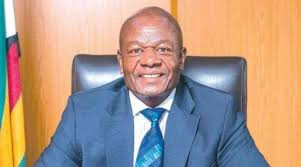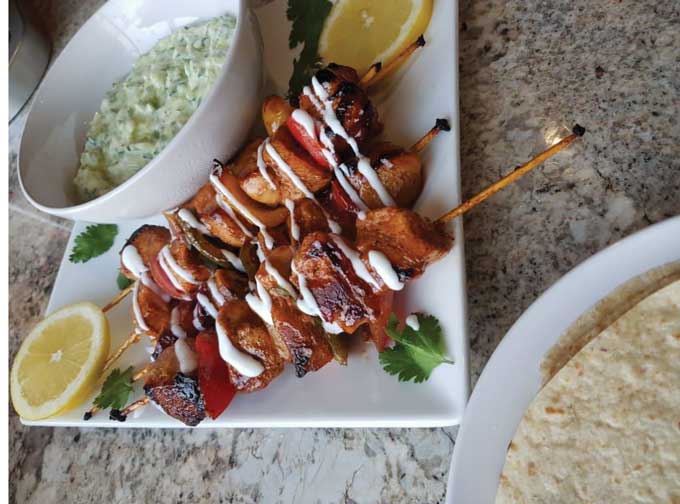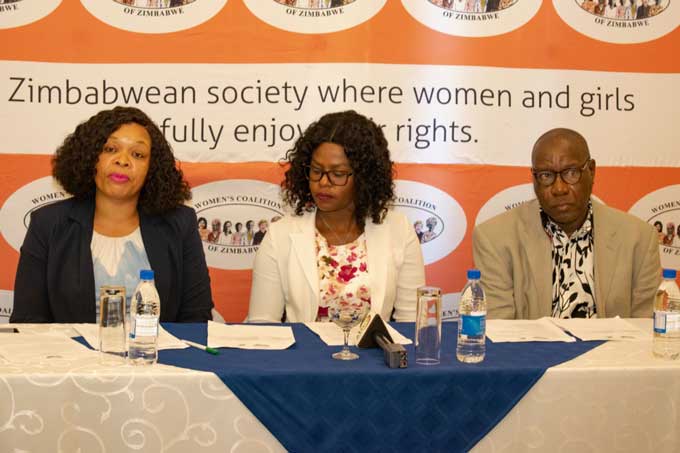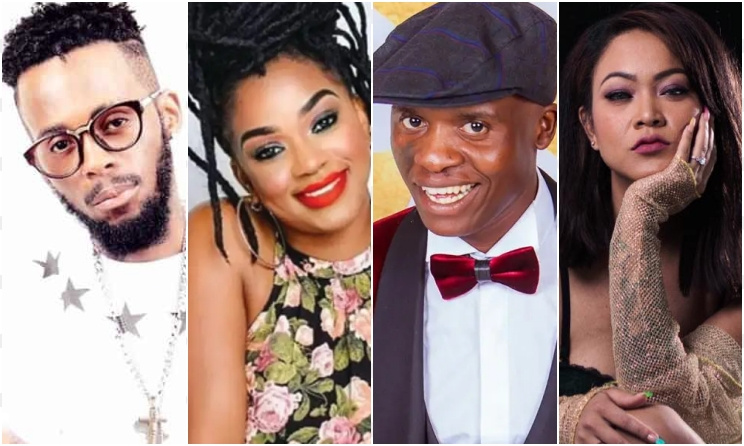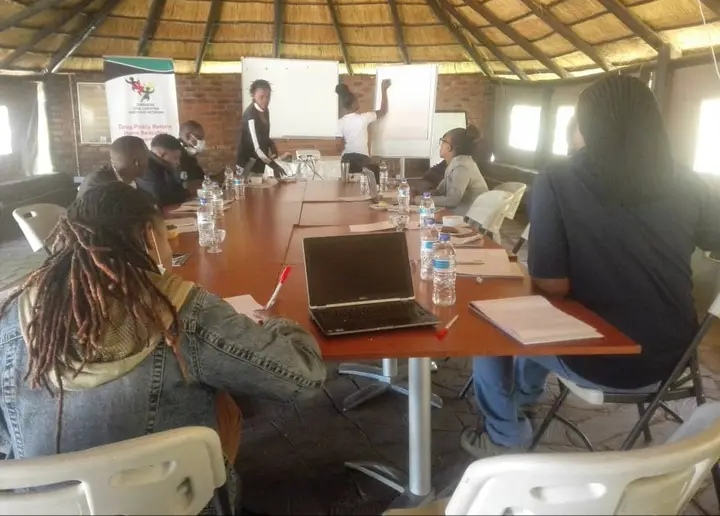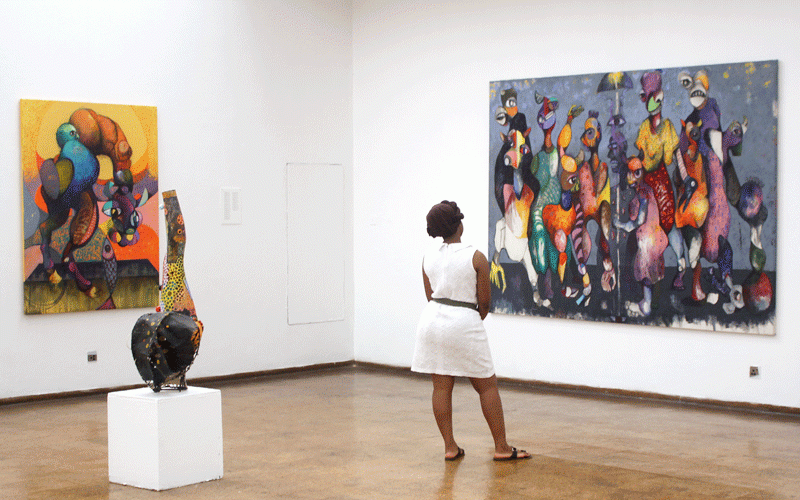
There is latent symbolism in having brothers Hugh Hatitye and Lionel Tazvitya Mbayiwa present Dzemudanga, a joint exhibition at the National Gallery of Zimbabwe (NGZ). Many have celebrated this occasion as the culmination of a journey propelled by love, care, and support. It may look like an easy accomplishment by two siblings from the backwoods of Mhondoro but comes from a more complex background as both artists casually and subtly reveal. A background permeated with subtle psychological contrasts as foreshadowed in their middle names. Dzemudanga can be read as a story of how fate endowed three brothers with a similar gift, and challenged them to navigate around each other’s ambitions.
Long before Lionel the younger brother took up some pencils, and became a student under Hugh for three years, there was Raymond the elder brother who started it all. Hugh confesses that he used to discreetly watch Raymond draw, and then go and try it in secret. Upon discovering it the elder brother must have seen it as a mockery of his craft. ‘’I was copying him… Of course, he didn’t like it.’’ Hugh tells Rugare Mdokwani of Eye Africa. Many years later, after being mentored by Hugh, Lionel reveals to Mdokwani, “He paved the way for me, and then I just had to keep the ball rolling, and also find myself in a different way so that I don’t have to be like him.” The seemingly banal and offhand remarks are a reflection of dynamic and subtle tensions which have influenced the trajectory in the careers of both men. It also shows that the strength of their filial bond is rooted deeper than a performative camaraderie.
As it turned out Raymond secedes to Hugh by taking the off-ramp and pursuing a career in graphic design. Lionel, who escapes from under his brother’s shadow by going to South Africa and re-inventing himself, tells Khumbulani Muleya of Heart and Soul TV (HStv) Book Club Sessions, “Moving to a foreign land led me to find myself. I was painting just like my brother…” Their two-men exhibition ironically compels viewers to seek out differences in style and attitude between brothers who were raised in the same household kwaMubaira, and share resources under Mbayiwa Studios.
Hugh leans heavily into abstraction with mesmerising detail. His artworks such as Pfuma yaSekuru and Taakuno (which are about bridal wealth, and migration respectively) hypnotise the audience with kaleidoscopic shapes and colour. Gazing into one of the paintings feels like taking an intergalactic flight across multiple dimensions, and through alternate realities reflecting time, history, and the shadows of the ancestors. The artist has commented that his work is about exploring heritage and Africanism. Hugh’s work, including all the sculptures on exhibition, is made up of the very fabric of society as he incorporates intimate found materials that are layered with meaning from the daily lives of contemporary Zimbabweans.
Fate compensated for its extravagance with his older brother by gifting Lionel with a figurative language in vivid colours that makes his work grab the viewers’ attention instead of politely waiting to be noticed. His works such as Ndibatewo muramu and Ndiberekeiwo (respectively about playful behavior between brother-in-law and sister-in-law, and bad leadership and its gullible victims) are deceptively lighthearted and satirical. The popular figurative works entice people to lean back and take a selfie but carry serious themes that question traditional norms, and challenge the political status quo. By his own admission Lionel’s work finds great appeal to the external gaze and gains favor from foreigners who are attracted by his use of bold colors, mythical figures, and authenticity derived from his rural upbringing.
In essence the difference between artwork produced by the Mbayiwa brothers is illusory. By adjustment of perspective one can see a Hugh Mbayiwa if they zoomed deep into a Lionel Mbayiwa. Likewise, an outline similar to Lionel’s cartographic figures can be seen by standing far enough from several artworks by his brother. It is difficult to pick one against the other. Musician Winky D explored the concept from the title of the exhibition in his song with a similar title, chanting Uchamhanya nebhuru ripi? Uchaziva sei iri riri weak, sezvo achifurira pamwe chete... Like two sides to a coin, the artists’ different technical approaches come from one reality expressing itself in multiple ways in order to experience itself fully.
Dzemudanga is a celebration of brotherhood and keeping it real. As Lionel would say, in completion of the Shona proverb from which the title of the exhibition is derived, Dzemudanga dzinorwa, dzemudanga dzinonanzvana, dzemudanga dzinotsvagana. The proverb affirms that brothers may antagonise each other, but they also heal each other, and find their way back to each other. Curated by the seasoned tag-team of Fadzai Muchemwa (Curator for Contemporary Art at NGZ) and Zvikomborero Mandangu (Assistant Curator) the exhibition is more than a show of aesthetic objects, it is a seismic cultural moment.
- About reviewer
- Nyadzombe Nyampenza is an art critic, photographer, and Conceptual Artist. In 2023 he was the NAMA recipient for Outstanding Journalist (Print). He was awarded Second Prize at the Zimbabwe Annual Art Exhibition (2016), and represented Zimbabwe at Bamako Encounters (Photography Biennale) in Mali (2015). Nyadzombe was the 2020 Fellow at Apex Art, in New York City. He is passionate about non-fiction creative writing and his ambition is to raise public awareness about visual arts from Zimbabwe through engaging, accessible, critical, and entertaining narratives.
- Are you a reviewer khumbulani@heartandsoul.co.zw
- How did we end up here?
- Mbayiwas exhibit ‘Dzemudanga’ at the Harare NGZ
- Dzemudanga: A reflection on brotherhood and ambition

